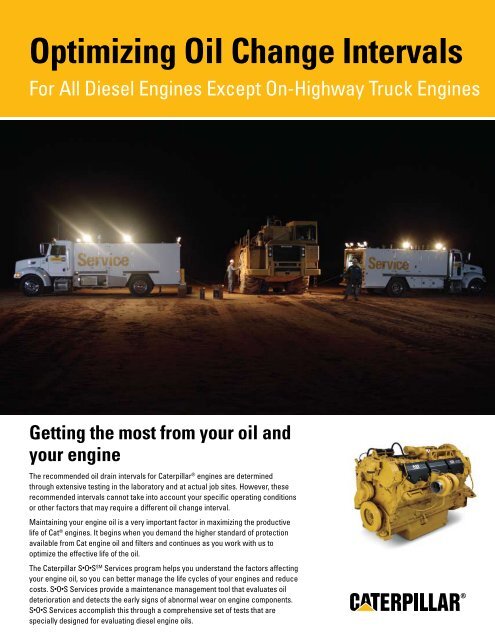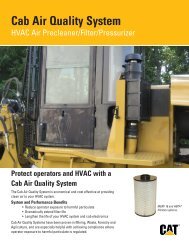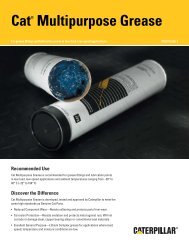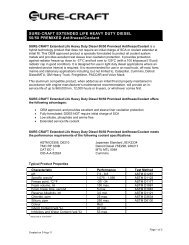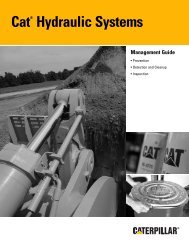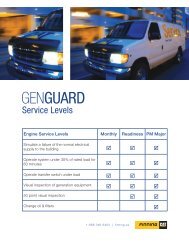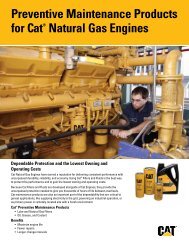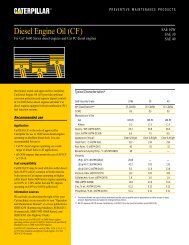Optimizing Oil Change Intervals.pdf
Optimizing Oil Change Intervals.pdf
Optimizing Oil Change Intervals.pdf
Create successful ePaper yourself
Turn your PDF publications into a flip-book with our unique Google optimized e-Paper software.
<strong>Optimizing</strong> <strong>Oil</strong> <strong>Change</strong> <strong>Intervals</strong><br />
For All Diesel Engines Except On-Highway Truck Engines<br />
Getting the most from your oil and<br />
your engine<br />
The recommended oil drain intervals for Caterpillar ® engines are determined<br />
through extensive testing in the laboratory and at actual job sites. However, these<br />
recommended intervals cannot take into account your specific operating conditions<br />
or other factors that may require a different oil change interval.<br />
Maintaining your engine oil is a very important factor in maximizing the productive<br />
life of Cat ® engines. It begins when you demand the higher standard of protection<br />
available from Cat engine oil and filters and continues as you work with us to<br />
optimize the effective life of the oil.<br />
The Caterpillar S•O•S SM Services program helps you understand the factors affecting<br />
your engine oil, so you can better manage the life cycles of your engines and reduce<br />
costs. S•O•S Services provide a maintenance management tool that evaluates oil<br />
deterioration and detects the early signs of abnormal wear on engine components.<br />
S•O•S Services accomplish this through a comprehensive set of tests that are<br />
specially designed for evaluating diesel engine oils.
Determining Optimal <strong>Oil</strong> <strong>Change</strong> <strong>Intervals</strong><br />
Work with our experts<br />
We will work with you to optimize the oil change intervals for your Cat engines. Keep in mind, the process of determining new oil change<br />
intervals is not simple. It requires that you work closely with your dealer over a period of several months. Once new intervals are established,<br />
it will be more important than ever to carefully monitor oil performance and engine wear. Use S•O•S Services for both oil and coolant<br />
analysis, to make sure there are not any problems.<br />
Extend oil drain intervals<br />
We suggest you proceed beyond the manufacturer’s recommended<br />
oil change period cautiously. First, determine that wear rate and<br />
oil condition are satisfactory at the recommended interval. Then,<br />
extend to the recommended interval plus 50 hours. Stay with the<br />
new interval for several changes and closely monitor the S•O•S<br />
results. If wear results remain acceptable, proceed again to a plus<br />
100 hour interval.<br />
Four types of oil samples<br />
There are four categories of oil samples involved in evaluating an<br />
oil change interval:<br />
• Samples of new oil<br />
A sample of new oil is needed as a test reference to the used oil.<br />
The new oil must be the exact same oil as the used oil being tested.<br />
Any time a new shipment of oil is received, a best practice is to<br />
take a sample to monitor the characteristics and cleanliness.<br />
• Baseline samples<br />
After changing the oil and filter, run the engine until it reaches<br />
operating temperature (about 15 minutes) and take a sample. This<br />
determines wear metal carryover from any oil left in the pan from<br />
the previous interval. It also reveals if any external contaminants<br />
were introduced through the oil fill process. During the evaluation<br />
period, take a baseline sample after every oil change.<br />
Proceed with caution<br />
We suggest that when evaluating engines with<br />
a 500-hour recommended oil change that you<br />
move forward cautiously. Some applications<br />
and conditions may allow for oil drain interval<br />
extensions, but some extreme applications<br />
and conditions may require more frequent oil<br />
changes.<br />
• Samples at shortened intervals<br />
Taking samples at less than the recommended oil change interval<br />
is essential to monitoring the oil degradation process. This will<br />
allow you to determine a trend line for wear accumulation and any<br />
external contamination entry. You must establish these rates for the<br />
recommended oil change interval before you begin an extended<br />
interval evaluation.<br />
• Samples at oil change<br />
Test results from the samples taken at the time of each oil<br />
change will indicate the final levels of oil degradation and wear<br />
accumulation. These results, along with the shortened interval<br />
sample results will be evaluated to establish the optimal oil change<br />
interval for your engine. Once the optimal interval has been<br />
established, submit a sample at each oil change.<br />
2
Consider these factors when evaluating your oil performance:<br />
Everything that could have an impact on oil condition must be held constant during the evaluation period. The following list of<br />
parameters must be under control for an effective evaluation:<br />
• Service intervals<br />
Your maintenance system must be capable of maintaining a plus or<br />
minus 10% margin on oil changes. Also, additional oil samples must<br />
be taken during the evaluation period. Maintenance personnel must<br />
be available to take these samples in a timely manner.<br />
• Filters<br />
To minimize risk and provide the best filtration, use genuine Cat oil<br />
filters, fuel filters, and air filters. <strong>Change</strong> the oil and fuel filters at<br />
the recommended intervals. <strong>Change</strong> air filters as required by the air<br />
restrictor indicator. Always use Cat filters to guarantee the highest<br />
quality filter available.<br />
• Engine oil<br />
Cat DEO TM (Diesel Engine <strong>Oil</strong>) is recommended for optimized oil<br />
drain programs. Cat DEO exceeds the requirements of the latest<br />
Caterpillar ECF (Engine Crankcase Fluid) specification and the latest<br />
American Petroleum Institute (API) category. Cat DEO contains the<br />
best additive package and base oil stock to help you achieve longer<br />
oil use and maximum engine life.<br />
• Cooling system maintenance<br />
Inadequate cooling system maintenance can eventually lead to<br />
system problems or even engine failure. Initially submit coolant<br />
samples for S•O•S Level 2 Coolant Analysis to assure the cooling<br />
systems on all test units are optimal. Continue using S•O•S Level 1<br />
Coolant Analysis at each oil change. Verify that radiators are clean<br />
of debris both internally and externally. Maintain proper coolant<br />
levels and coolant conditioner levels.<br />
• Engine Maintenance<br />
Keep engines running according to specifications. Check boost,<br />
fuel settings, air/fuel ratio control and transmission shift points.<br />
Poorly tuned engines can lead to malfunctions or adversely affect<br />
operating temperatures, fuel consumption or other parameters<br />
contributing to premature engine failure.<br />
• Selection of test engines<br />
Include engines with relatively low total operating hours.<br />
Engines with higher hours may have different wear rates and<br />
oil consumption rates than newer engines. Recently overhauled<br />
engines are also good candidates for oil drain interval optimization.<br />
• Operating practices<br />
Operating techniques impact how an oil responds and holds up in<br />
your application. Excessive lugging, excessive idling and full throttle<br />
on/off will all effect sooting and oxidation of oil. The same load<br />
should be applied in the same operating and climatic conditions.<br />
Provide Complete S·O·S Information<br />
Be sure to correctly and completely fill out<br />
the S•O•S sample bottle label. The information<br />
is crucial to insure accurate interpretation<br />
of the data. It is essential to include the total<br />
hours or odometer units on the engine and oil,<br />
and the quantity of make up oil added since<br />
the last oil change.
<strong>Optimizing</strong> <strong>Oil</strong> <strong>Change</strong> <strong>Intervals</strong><br />
The oil change interval balance<br />
As with most business decisions, establishing an engine oil change interval beyond the manufacturer’s recommendation has both<br />
risks and rewards. Perhaps the biggest potential reward is increased availability due to less maintenance downtime. But this<br />
increased availability can be quickly eroded if extended oil drains are causing premature wear and repair downtime. Extending<br />
oil change intervals without a carefully planned and executed program is gambling with the life of your engines-and your cost of<br />
operations. Call your Cat Dealer today for more information.<br />
Rewards<br />
Risks<br />
Increased Availability and Productivity<br />
Decreased <strong>Oil</strong> and Filter Costs<br />
Decreased Maintenance/Labor Costs<br />
Decreased Disposal Costs<br />
Decreased Availability and Productivity<br />
Decreased Engine Life<br />
Increased Repair Downtime<br />
Increased Repair Costs<br />
At some oil change interval, there is reasonable balance.<br />
Cat ® Dealers define worldclass<br />
product support.<br />
We offer you the right parts and service<br />
solutions, when and where you need them.<br />
The Cat Dealer network of highly trained<br />
experts keeps your entire fleet up and running<br />
to maximize your equipment investment.<br />
PEHJ0192<br />
www.cat.com<br />
© 2007 Caterpillar • All Rights Reserved • Printed in USA<br />
CAT, CATERPILLAR, their respective logos, S•O • S, “Caterpillar Yellow” and the POWER EDGE trade dress, as well as<br />
corporate and product identity used herein, are trademarks of Caterpillar and may not be used without permission.


